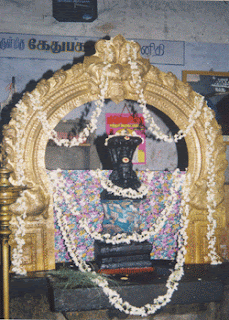Sri Ranganathaswamy Temple, Srirangam
The Sri Ranganathaswamy Temple in Srirangam, Tiruchirapalli, Tamil Nadu, India is a Hindu temple dedicated to Lord Ranganatha, a reclining form of Lord Vishnu. It is the first and foremost among the 108 Divya Desams, the holy abodes of Lord Vishnu. It is also considered to be one among the eight Svayam Vyakta Ksetras ("self-manifested shrines") of Lord Vishnu.[1]
The temple is also well known for its architectural grandeur. The annual 21 day chariot festival conducted during the month of Margazhi (Dec-Jan) attracts lot of visitors. Everyday during the festival, the sacred Vaishnavite text, Tiruvaimozhi is recited before Lord Ranganatha.
Srirangam temple is often listed as the largest functioning Hindu temple in the world (Angkor Wat being the largest non-functioning temple). The temple occupies an area of 156 acres (631,000 m²) with a perimeter of 4,116m (10,710 feet) making it the largest temple in India[2] and one of the largest religious complexes in the world. The temple is enclosed by 7 concentric walls (termed prakarams or mathil suvar) with a total length of 32,592 feet or over six miles. These walls are enclosed by 21 Gopurams. The space within the outer two prakarams is occupied by several shops, restaurants and flower stalls. For this reason, other massive Hindu temples like Chidambaram (Nataraja swamy Temple), Tiruvannamalai (Annamalaiyar temple), Meenakshi Amman Temple, Tirunelveli Nellaiappar Temple claim to be the biggest Hindu temples (Note - all these magnificent temples are entirely dedicated for the religious rituals and are "massive" in every sense of the word - size, grandeur and the accompanying traditions).
Among the marvels of the temple is a Hall of 1000 Pillars (actually 953) which has intricately carved stone pillars.
Though the term Kovil is generically used in Tamil to signify any temple, for many Vaishnavas the term Kovil exclusively refers to this temple, indicating its extreme importance for them (for saivas the term kovil refers to Thilai Natarajar Golden Shrine (Chidambaram Temple)). The presiding deity Lord Ranganathar is praised in many names by His devotees, including "Nam-Perumal" (our Lord in Tamil), "Azhagiya Manavalan" (The beautiful groom in Tamil), while His divine wife Ranganayaki is affectionately called "Thayar" (Holy Mother).
Apart from the main shrine of Ranganathar, the complex also houses shrines of dozens of forms of Lord Vishnu including Sudarshana Chakra, Narasimha, Rama, Hayagreeva, Gopala Krishna, separate shrines for Ranganayaki and dozens of other shrines for the major saints in the Vaishnava tradition, including Ramanuja. The temple follows the Thenkalai sect of Iyengars, but it is also worshipped by traditional Vadakalai sect of Iyengars, as is the case with all Vaishnavite shrines. Non-Hindus are allowed up to the sixth prakaram but not inside the gold topped sanctum sanctorum.[3]
Sriranga Mahathmiyam is the compilation of religious accounts of the temple, detailing the origins of its greatness. According to it, Lord Brahma, the Lord of Creation in Hindu mythology was once in a state of deep meditation and in His supreme trance received the gift of the Lord Vishnu's idol, "Ranga Vimana". He was told by the Supreme Lord that there would be seven other appearances of such idols on earth -- Srirangam, Srimushnam, Venkatadri (Tirumala), Saligram (Muktinath), Naimisaranya, Totadri, Pushkara and Badrinath.[4] The idol was then passed on by Brahma to Viraja, Vaiswatha, Manu, Ishwaku and finally to Rama. Lord Rama, himself an Avatar of Vishnu, worshipped the idol for a long time, and when he returned victoriously from Sri Lanka after destroying Ravana, he gave it to King Vibhishana as a token of appreciation for the latter's support for Rama against his own brother, Ravana. When Vibhishana was going via Trichy en route to Sri Lanka, the Lord wanted to stay in Srirangam.

The location where the Ranganathan idol was placed was later covered by an overgrowth of deep forests, due to disuse. After a very long time, a Chola king, chasing a parrot, accidentally found the idol. He then established the Ranganathaswamy temple as one of the largest temple complexes in the world.
According to historians, most dynasties that ruled the South—Cholas, Pandiyas, Hoysalas, Nayakkas—assisted with renovation and in the observance of the traditional customs. Even during periods of internal conflicts amongst these dynasties, utter importance was given to the safety and maintenance of these temples. It is said that a Chola king presented the temple with a golden serpent couch. Some historians identify this king with Rajamahendra Chola, supposedly the son of Rajendra Chola II. But it is of interest to note that he never figures in the latter's inscriptions, neither in the 4th year (that shows various members of the family going on rampage in different regions) nor in the 9th year (that shows only one member of the second generation).
The temple is mentioned in Tamil works of literature of the Sangam era, including the epic Silapadikaram (book 11, lines 35-40):[5]
“ On a magnificent cot having a thousand heads spread out, worshipped and praised by many, in an islet surrounded by Kaveri with bellowing waves, the lying posture of the One who has Lakshmi sitting in his chest
āyiram viritteḻu talaiyuṭai aruntiṟaṟ
pāyaṟ paḷḷip palartoḻu tētta
viritiraik kāviri viyaṉperu turuttit
tiruvamar mārpaṉ kiṭanta vaṇṇamum
”
However, archaeological inscriptions are available only from the 10th century AD.[6]
List of Shrines inside Srirangam Temple
Srirangam temple has around 360 shrines dedicated to various deities and Gurus.The following list provides some of the names
1) Lord Ranganatha
2) Goddess Ranganayaki
3) Lord Sudarshana
4) Lord Dhanvantri
5) Sri Ramanuja
6) Lord Garuda
7) Sri Vedanta Desika
8) MeetAlagiya Singar ( Narasimha)
9) Sri Thuluka Nachiyar
10) Lord Vishwaksena
11) Sri Aandal
12) Lord Venugopala Krishna
13) Lord Pattibhisheka Rama
14) Dasavatara Moorthis
Darshan, sevas and festivalsThere are Festivals throughout the year (Approx. 322 days out of 365 days). Vaikunta Ekadesi is the most important festival in Sri Rangam. AdiBrahmotsavam festival during Tamil month of Panguni is celebrated with pomp and glory.
































